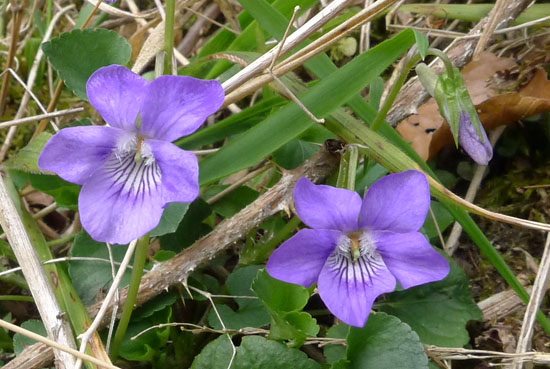
Common Dog-violet, Viola riviniana: Spring herbage

Common Dog-violet, Viola riviniana, is the most common violet in the UK and provides some useful herbage for a wild salad, particularly in the spring. It flowers March to May and is then easy to spot but a little less so at other times. The leaves and flowers are edible. The leaves are fairly bland, having a pleasant flavour with only a little bitterness, if any, making it a wild food worth picking up as you forage.
The leaves of most violets have quite a lot in common. But before we get into a tailspin about differentiating between similar violets, we should remember what Professor Gordon Hillman writes in Wild Food “The leaves and flowers of all members of the violet family seem to be edible”.

The leaves of the common dog-violet are heart-shaped, smooth, almost without hairs and with regularly-spaced indentations around the edges. The flowers are an attractive blue-violet with five petals. The lower petal or lip has prominent veins. The flower’s sepals are pointed. All violets in the British Isles have a spur which sticks out behind the flower; one of the key identification features of V. riviniana is that its spur is lighter in colour than the petals and is notched at the tip.

Remember to take only a few leaves from any particular plant so as not to damage it too much. Please read the BSBI’s Code of Conduct for the Conservation and Enjoyment of Wild Plants for guidance on the best practice and the law.

patches of the plant. Always pick in moderation so that plenty is left for others to enjoy. Photo: Paul Kirtley.
Recommended Books for Further Reading:
Related Articles on Paul Kirtley’s Blog:
Foraging for Early Spring Greens: Some to Eat, Some to Avoid…
Conopodium majus: Pignuts and How to Forage for them
Brooklime, Veronica beccabunga
Primrose, Primula vulgaris: Wild food?
Disclaimer
This article is meant only as a guide and is largely a record of my recent forages. It is not a complete treatment of all edible plants that might be available. Nor does it provide a complete treatment of all poisonous plants that may also be present in the habitat where you find the above-mentioned plants. If you want to learn more about plant identification you should invest in some good field guides. The safest way to learn about edible wild plants is for someone who already has the knowledge to show you in person. Any foraging you do on your own is at your own risk.
The most important thing to remember when identifying wild foods is:
IF IN DOUBT, LEAVE IT OUT!
10 thoughts on “Common Dog-violet, Viola riviniana: Spring herbage”
Hello Paul,great article , i enjoyed some of these the other week with some Salami whilst resting after a long walk.There are plenty around by me so i will probably gather some more on another outing.
Regards
Darren
Thanks Darren, good to hear you enjoyed the article. And the violets – a delicious combination with the salami.
All the best
Paul
Ate my first violet (and flower) yesterday. Decent taste actually, good to add some diversity.
Hi Pierre
Nice to hear you tried them and liked them. Diversity in foraging is always good 🙂
All the best
Paul
Nice articles. Planning a short walk this weekend to see what I can find and taste!
Regards, Joep
Hi Joep. Enjoy your walk and your weekend. I hope the weather over there is as good as it is over here. Let us know if you find anything interesting.
All the best
Paul
Another Interesting Piece Thanks Paul for taking the time to write about this subject.
when ever I try a foraged edible I find it a taste that has to be learnt, do you think that with our modern sweetened pallet that we might at some point find some wild plants to be so bitter or of a taste that is simply unpalatable? what would you recommend to try on your first forays into the world of foraged foods as a soft way in?
Looking forward to your reply
Dave,
Hi Dave
I think also a lot of the salad leaves we can buy these days are pretty bland.
For foraged foods with good flavour by our modern standards, that aren’t going to offend beginners, here’s a dozen that are easily recognised and require no processing:
Wood sorrel
Wood Bittercress or Hairy Bittercress
Lady’s Smock
Wild Garlic (Ramsons)
Pignut
Wild Strawberry
Bilberry
Raspberry
Blackberry
Redcurrants
Wild Cherry
Water Mint
These are not all available at the same time of year, of course, but this is good as it means you can delight people with different things at different times of the year…
All the best
Paul
Brilliant ,thank you, time to gets the books out to the tracks I think, have a look what’s about.